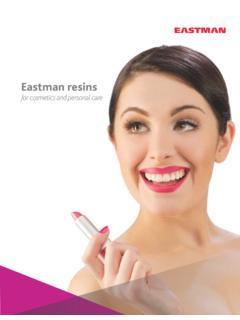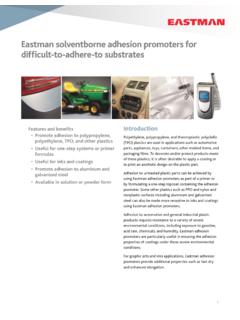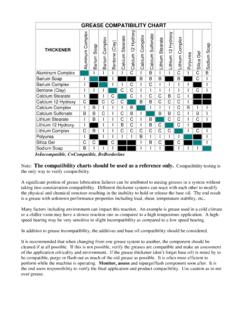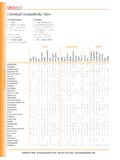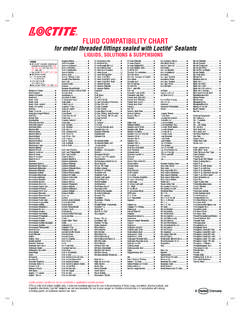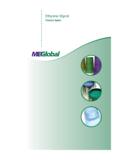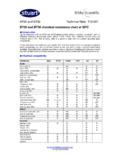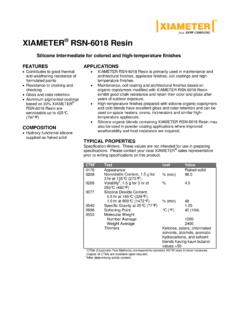Transcription of E-309B Compatibility of EASTMAN Cellulose Acetate Butyrate ...
1 The mixed Cellulose esters ( Cellulose Acetate Butyrate [CAB] and celluloseacetate propionate [CAP]) are usually modified by the addition of otherresins to improve adhesion, flexibility, abrasion resistance, outdoorweathering, etc. Many compatible resins are available in Europe for thispurpose. This publication presents the results of a study of the compatibilityof EASTMAN lacquer-grade and ink-grade Cellulose esters with a number ofdifferent European resins including acrylic, alkyd, amino, isocyanate,ketone, maleic, and polyester ofEastman Cellulose AcetateButyrate/ Cellulose Acetate Propionate and European ResinsContentsCompatibility1 Compatibility Study1 Method1 Cellulose esters and Techniques3 Compatibility Data4 Acrylic Resins4 Thermoplastic4 Thermoset4 Alkyd Resins5 Amino Resins6 Benzoguanamine6 Melamine6 Urea7 Isocyanate Resins7 Maleic Resins7 Polyester Resins81 CompatibilityCompatibility StudyIt is usual to refer to Cellulose ester/resin Compatibility or incompatibility to denote whether the combination gives a clear or a hazy film.
2 However, resin blends may be incompatible in a strictlythermodynamic sense and yet give clear films. Clarity is achieved when the refractive index difference and the domain size of the individualcomposition are sufficiently small that the eye is unable to perceive a Cellulose ester/resin combination will be reported ascompatible by one laboratory and incompatible by another. The apparentdiscrepancy may be caused by a difference in solvents used for compatibilitytesting, difference in drying or stoving conditions, difference in applicationtechniques, or difference in film thickness. Compatibility results may alsovary with the technique used for evaluation. It is common practice to examine film under daylight conditions, although it can be done byprojecting a strong beam of light through the film in a darkened , it should be noted that resin Compatibility may be appreciablyaltered by the other components of a formulation.
3 Compatible systemscan often be obtained with three or more components when two of theindividual components in the mixture are incompatible with each determine the performance of a particular Cellulose ester/resincomposition, it should be tested in the specific formulation and under the specific conditions under esters and modifying resins were dissolved in ethyl Acetate 99 percent at 20 weight percent solids. With some resins, it was necessaryto add 5 10 weight percent isobutyl alcohol, EASTMAN EEP solvent, orxylene to achieve a soluble mixture prior to testing for Compatibility withthe cellulosic resin. The solutions were mixed in ratios of 1:9, 1:4, 1:1,and 4:1 and coated on clear glass plates at 150 250 m dry film air drying for 5 15 minutes, the coated glass plates were stoved inan air oven for 30 minutes at 115 C.
4 When cooled to room temperature,the coatings were examined for clarity in diffused light with a blackbackground and also in direct sunlight. Assessments on compatibilitywere made on the following basis:Compatible (completely clear film)Very Slightly IncompatibleSlightly IncompatibleIncompatible (translucent to opaque film) Compatibility ofEastman Cellulose Acetate Butyrate / Cellulose Acetate Propionate and European Resins2 Cellulose esters StudiedThe following EASTMAN CAB and CAP esters were tested forcompatibility with a wide variety of European and Compatibility of is normally similar to those cases where it is not the same, data for is reportedfollowing a diagonal (/) mark.
5 Thus, C/VSI indicates that is compatible and is very slightly incompatible with themodifying resin. A glance at the chart shows where the compatibilitydifferences are between the two resins. Compatibility of the lower-viscosity and higher-viscosity CAB-381 esters ( , CAB-381-2and CAB-381-20) can be assumed to be the same as that reported alcohol-soluble Cellulose esters were included in the study: and The former is soluble in anhydrous ethylalcohol, but the latter requires at least 5 percent water or a lowpercentage of an active solvent such as ethyl Acetate to achieve a clearsolution. Both are also soluble in conventional lacquer for , the study does not indicate Compatibility atvery high levels of resin modification (1:9).
6 CAB is often used as anadditive in other coating compositions. For example, a small amount ofthe cellulosic can be added to thermoplastic or thermosetting finishes toimprove application and performance properties. The most notableimprovements are reduced cratering, quicker dust-free time, and betterpigment control. is a low-molecular-weight Cellulose esterthat is used primarily as an additive or as a polyol reactant. It provides theusual benefits of improved flow control, pigment control, and techniques for Eastmanlacquer-grade Cellulose esters mayvary from those used with nitrocellulose lacquer chief differences are as follows:1. Films of mixed Cellulose esters soften more readily when modified with resin or plasticizer than do nitrocellulose films.
7 Thus, to avoidsoftening of the film, coatings containing EastmanCAB and CAPshould be formulated with less plasticizer than is used A slight haze may result from using medium-evaporating or slow-evaporating esters or ketones. This occurs if they are the last solventsto evaporate from films containing alkyd or maleic resins modified withCAB. If haze occurs, a change to an aromatic hydrocarbon as theslowest-evaporating solvent may yield a clear The density difference between mixed Cellulose esters and nitrocellulosemust be considered. The density of EastmanCAB and CAP isapproximately 1,200 grams per litre, as compared with approximately1,600 grams per litre for nitrocellulose.
8 A CAB wood lacquerformulated at weight percent nonvolatile would giveapproximately the same coverage in microns per square meter as woulda nitrocellulose lacquer at weight percent nonvolatile. The densitydifference is particularly important in pigmented coatings or inks. Toconvert a pigmented nitrocellulose ink formulation to a CAP or CABformulation, it must be done on a volume basis, not on a weight basis,to maintain the pigment-to-binder ratio and therefore the colorstrength of the reformulated DataACRYLIC :Resin RatioCAB:Resin RatioCAP:Resin RatioCAP:Resin RatioCAB:Resin RatioThermoplasticSupplier1:41:14:11:41: 14:11:41:14:11:41:14:11:91:41:14:1 Neocryl B-723 Neo Resins, CCCCVSIVSISISISICSISICCCCN etherlandsNeocryl B-728 Neo Resins, VSI/SIIVSI/SIIIIVSIVSIVSICVSIVSI NetherlandsNeocryl B-735 Neo Resins, CCCCVSIVSICSIVSICVSIVSICCCCN etherlandsNeocryl B-736 Neo Resins, CCCCCSICIIVSIVSIVSICCCCN etherlandsNeocryl B-805 Neo Resins, CCCCVSIVSIVSISISICCCCCCCN etherlandsNeocryl B-810 Neo Resins, CCCCCCIIIIIC NetherlandsNeocryl B-813 Neo Resins, SI/C SI/C SI/CCISISISICCIVSICCCCN etherlandsNeocryl B-814 Neo Resins, CCCCCC CCCCN etherlandsDegalan M 345 Roehm, GermanyCC/I C/VSISISIVSI Degalan M 920 Roehm, GermanyCCC Degalan MB 319 Roehm.
9 GermanyCCCCIC CCCCD egalan N 80 Roehm, GermanyCCCCSICCCCCCCCCCCD egalan N 742 Roehm, GermanyCCCSIICCCCCCCCCCCD egalan P 675 Roehm, GermanySI/C SI/C VSI/CSISISI CCCCD egalan PM 381 Roehm, GermanyCCCSIICIIIIICCCCCD egalan PM 685 Roehm, GermanyCCCCSISISISICCSISICCCCS urcol 836 Ciba SpecialtyC/VSI VSI C/VSIVSIVSICSIVSIVSICCC Chemicals, UKThermosetDegalan LP 62/03 Roehm, GermanyCVSI/CCSISIVSI CCCCD egalan LP 68/04 Roehm, GermanyC/SICCCCC Jagotex F 232 EASTMAN Chemical I/CI/CI/CIISI CCCCJ aeger, GermanyJagotex F 256 EASTMAN Chemical I/VSISICIIVSI Jaeger, GermanyMacrynal SM 500 Solutia, GermanyI/II/SII/CIII Macrynal SM 540 Solutia, GermanyI/SI I/VSI I/VSIIII Setalux 1151 XX-51 Akzo Nobel Resins, I/VSI I/VSII/CISISI NetherlandsSetalux 1385 BX-51 Akzo Nobel Resins, CCCCCC CCCCN etherlandsC = CompatibleVSI = Very Slightly IncompatibleSI = Slightly IncompatibleI = Incompatible5 Compatibility DataACRYLIC (Continued) :Resin RatioCAB:Resin RatioCAP:Resin RatioCAP:Resin RatioCAB:Resin RatioThermosetSupplier1:41:14:11:41:14:1 1:41:14:11:41:14:11:91:41:14.
10 1 Synocure 867 SCray Valley, UKI/SIIC/IIISIIISIISIC Synocure 869 SDCray Valley, UKCCCCVSISICSICCCCCCCCU racron CS 104 MDSM Resins, IIIIII NetherlandsUracron CY 451 XEDSM Resins, CCCCCC CCCCN etherlandsUracronCR201 SIDSM Resins, SI/C VSI/CCIVSIVSI CCCCN etherlandsALKYD :Resin RatioCAB:Resin RatioCAP:Resin RatioCAP:Resin RatioCAB:Resin RatioSupplier1:41:14:11:41:14:11:41:14:1 1:41:14:11:91:41:14:1 Vialkyd AC 421 Solutia, GermanyI/VSI I/SI SI/VSIVSISIVSI CCCCV ialkyd AF 360 Solutia, GermanyI/VSIISI/IVSIISI Vialkyd AN 950 Solutia, GermanyCCCCCC CCCCC ardura E10 Resolution Performance CCCCCCCSIICCCCCCCP roducts, NetherlandsDuramac307-1382 EASTMAN ChemicalIIIIII Company, UKDuramac307-2009 EASTMAN Chemical, ItalyCCC Uralac P810 DSM Resins, CCCCS2G3-60 NetherlandsUralac AM181 X-60 DSM Resins, CCC NetherlandsUralac AN621 S2 DSM Resins, ICC NetherlandsUralac AK424 X-60 DSM Resins, IIIIII NetherlandsUralac AD525 X-60 DSM Resins.





